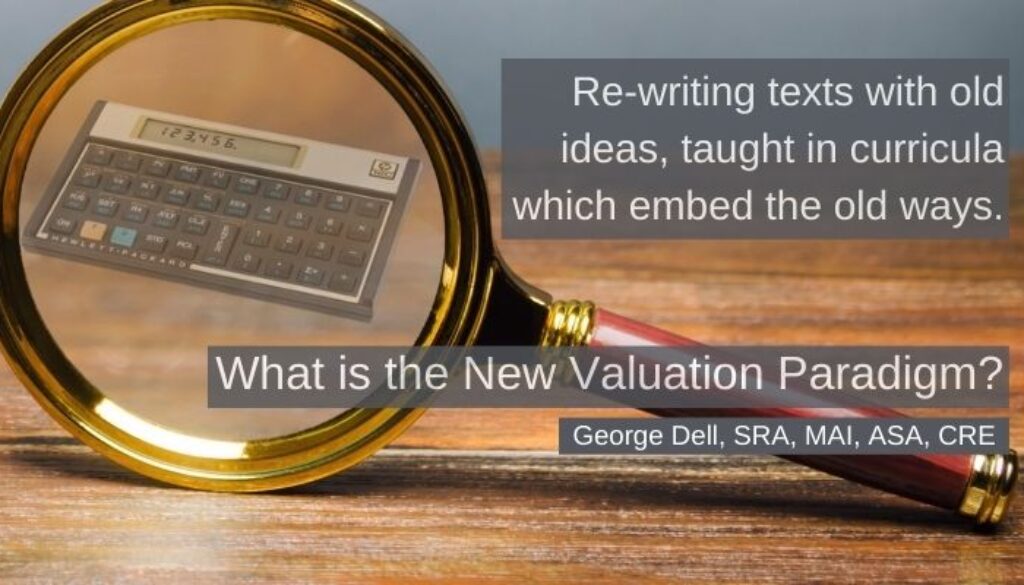Appraisals, AVMs, evaluations, Broker opinions, and “homeowner’s opinion” – valuation of any sort all have some things in common.
The “new valuation modeling paradigm” is a term coined by Marv Wolverton, PhD, MAI (who authored the AI book An Introduction to Statistics for Appraisers). He created the term in a response to my peer-reviewed Appraisal Journal article: “Common Statistical Errors and Mistakes: Valuation and Reliability.”
The “new paradigm” concept comes from three areas: technology, personal/group inertia, and the specialized primal functions of the human brain. Perception, or what the brain “gets,” is built for survival, not data analysis! This nature of the human brain and normal neural response is resistant to change, and acts on other organizational and legal implications.
Technology comprises two main parts. One is the availability of data. When I became an appraiser, there were no real sources of commercial property sales, other than public records and ‘who you know’ in the industry. This went to paper sources, including MLS and printed colored pages on various income property types. Advanced transistor calculators, such as the HP12c were all the rage. The reporting technology was the new, electric typewriter and automated electric stapler!
Today, data is complete in most areas, instantly available, and of far greater detail than back then.
Inertia is multi-dimensional psychology. It comprises normal human resistance to change, embedded traditional education, an aging appraiser demographic (including organizational leadership), organizational goals shifting to group survival (in place of forward-looking education). The rewriting of texts repeating old ideas, forwarded by teachers and curricula which embeds the old ways. Examinations which test old ways.
Example: One person I recently spoke to, a young computer-savvy man, was preparing for his final course exams for a major designation. The material was given with pre-prepared data sets – with no mention of how data is selected! This is the old way. “Trust me, I know a good comp when I see a good comp!” There is no need for traditional data analytics when opinion presides over actual analysis.
Today’s analytics, the new world of people of ‘science of data’ get that 80% is getting the data right, and the remaining 20% is predicting or estimating from that data.
More inertia is embedded in the standards of practice, which focus entirely on the objectivity of the appraiser, and not at all on the objectivity of the analytic methods. The tests of acceptability are reduced to simply: Do what everyone (peers) does. And do what your clients expect.
Then these third-party standards of practice become embedded in law. Now it is in States’ administrative law that an appraiser complies by “stating the value opinions and conclusions.” These standards and questioned laws only require “stating the appraisal methods and techniques employed.” It does not require showing verifiable work or results. (USPAP, Standard 2, Reporting)
Perception limits the human brain. The human brain is really good at finding patterns, noting anomalies (outliers), and generalizing from very little data (like 4 or 5 comps). Beyond that, it gets confused and tunes out. Strongly. It wants to go back to a comfort zone of ability.
Valuation has evolved from comparing comps to measuring markets. The old appraisal process insists on picking comps first, then defining the market. This is backwards. It’s like sitting down at a table in a Mexican restaurant, then looking for comparable Chinese food.

September 30, 2020 @ 6:32 am
I don’t often comment, but strongly compelled to here. A brilliant synopsis of the current state of the Valuation profession. It touches the many exposed raw nerve endings of the Canadian appraisal industry, which I’m familiar with. The phrase “organizational goals shifting to group survival (in place of forward-looking education)” is very prescient and sets my spidey senses tingling.
December 9, 2020 @ 4:06 am
Thank You, George, for explaining to us not only that he Emperor is buck-ass naked, but how and why as well. The real estate appraisal industry has done a less-than-stellar job demonstrating to clients why and how what we do is superior to AVMs. As you indicate, the issue with real estate appraisal not is not a lack of data. We have all we can handle (assuming we know where to get them – and that is not always or exclusively the MLS). Rather, it is how to analyze those data so the data will speak to us. Unfortunately many of our current data analyses techniques expect us to speak for the data. Keep up the good fight, George!